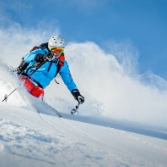News and Info
Safety Gear
TRANSCEIVER
Let’s get geeky about transceivers -
Things have moved on drastically in the last few years in the world of transceivers. Increased range, longer battery life and much more intuitive visual and audio signals. As I have mentioned before, every second counts when it comes to avalanche rescue, so it follows that the easier a transceiver is to use then the better the chances are of a positive outcome.
I have selected the market leaders and broken them down into a simple chart so you can easily compare the most relevant features.
Chart:
Brand/ Model
Cost
Search Distance
Switch to send
3 Antennas
Multiple Victim Capability
Weight
Batteries
Power duration
Comments: market leader, simplicity, fastest processor, dog search on a different frequency / inclinometer
The new Mammut Barryvox and Barryvox S are way ahead in this field and are my recommendation for winter 2017 / 2018.
Come to the shop and ask if you have any questions or drop us an email.
A PROBING EQUIRY
So, what are you looking for when it comes to probes?
Length, strength, clear depth markers, a solid tip for pushing through the packed snow, speed to get it into probing mode and finally cost.
Length – Somewhere around 240cm and 280cmcm is the accepted length, this should give you enough probe for most avalanche scenarios, however, if you don’t mind carrying the weight then longer is better. Any less than 240cm and you start to limit your ability to search effectively.
Strength – This is a product of the material used to make the probe. Normal materials include carbon and aluminium. Generally speaking, carbon probes are lighter but are not as easy to push through the hard-packed snow.
Depth markers – These are going to tell you how far you are going to need to dig once you have located the victim. They should be in a different colour and be easily counted.
The tip – Sometimes replaceable as they do become damaged if used lots of practise. It should be ergonomically shaped to be most effective at penetrating the snow.
Speed – This is the time taken to get the probe out of its bag and into full usage. This will be affected by the mechanism that is used to tighten the cord inside and lock it out. Ideally this should be possible with gloves on and in one pull of the handle or cord.
Cost- This will be mostly due to the material that it is made of and the mechanism that controls the cord within. The same thought process is true, that you don’t want to be left with your friend buried because of a broken or ineffective probe, so consider this when making the purchase.
Mountain Air’s top picks:
SHOVEL – Digging for survival
You have located your ski buddy with the beeper and then pin pointed them with the probe, now it’s time to get sweaty and do the digging.
Remember when digging to start 1.5 x times the depth of the victim downhill.
Don’t underestimate the density of the snow once it has stopped moving, this is going to be hard work. Especially since you will need to remain calm, however, that’s easier said than done. Trust me I have been there!
So, what you really don’t need in this situation is some sort of gear failure. When it counts you need to be able to trust in your equipment. With that in mind, what do you need from a shovel?
Blade size – Some people who race go for the minimum size technically allowed. In some cases when races are run and the avalanche risk is very low, plus the route has been checked, then it might save a few grams, however this is not most people. If you want one shovel to take you all over the mountain in a variety of situations both risky and less, forget about a small blade size and get something that will actually be able to dig.
Handle length – Most modern shovels come with an extendable handle which gives you the extra leverage that you need to be able to crunch through that hard-packed snow. The extra material adds weight, but weight worth carrying!
Handle shape, - If you are looking for a shovel that doubles up for another purpose like building a back-country kicker or constructing a snow wall around your tent on expedition, then a D shaped handle offers more control and precision. Most shovels come with a T shaped handle as it packs lighter and smaller in your bag.
Functionality – Digging can require several angles of excavation. Lots of shovels now can swap the shaft angle so the same blade can scoop and excavate. This is especially useful if there are two of you rescuing a victim at the same time. One can be at the “face” in excavating mode and the other can be back a meter in scoop mode clearing out.
Material – There are really only two choices for this. Carbon which offers a serious weight saving, but doesn’t always feel as sturdy and comes with a hefty price tag. Alternatively, the more common Aluminium. Good shovels normally have some sort of rib on the blade to give extra rigidity. Avoid plastic shovels.
One last thing to remember is that it needs to fit in your pack, and be easily and quickly accessible. It is also preferable to have holes in the blade so that you can use it as a snow anchor if necessary.





